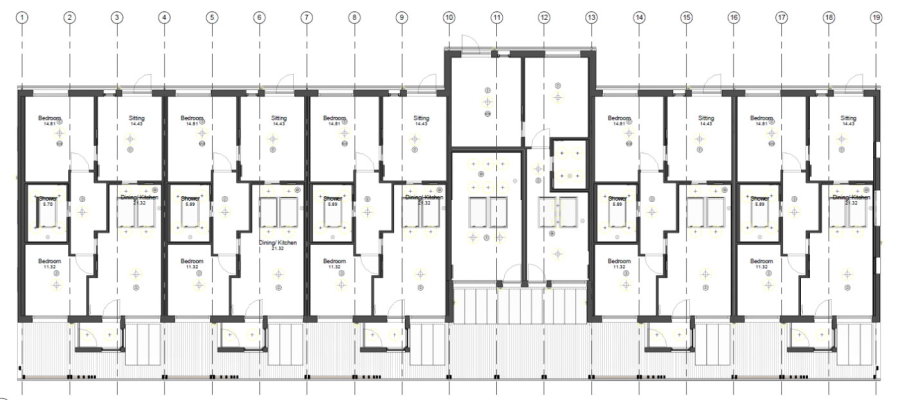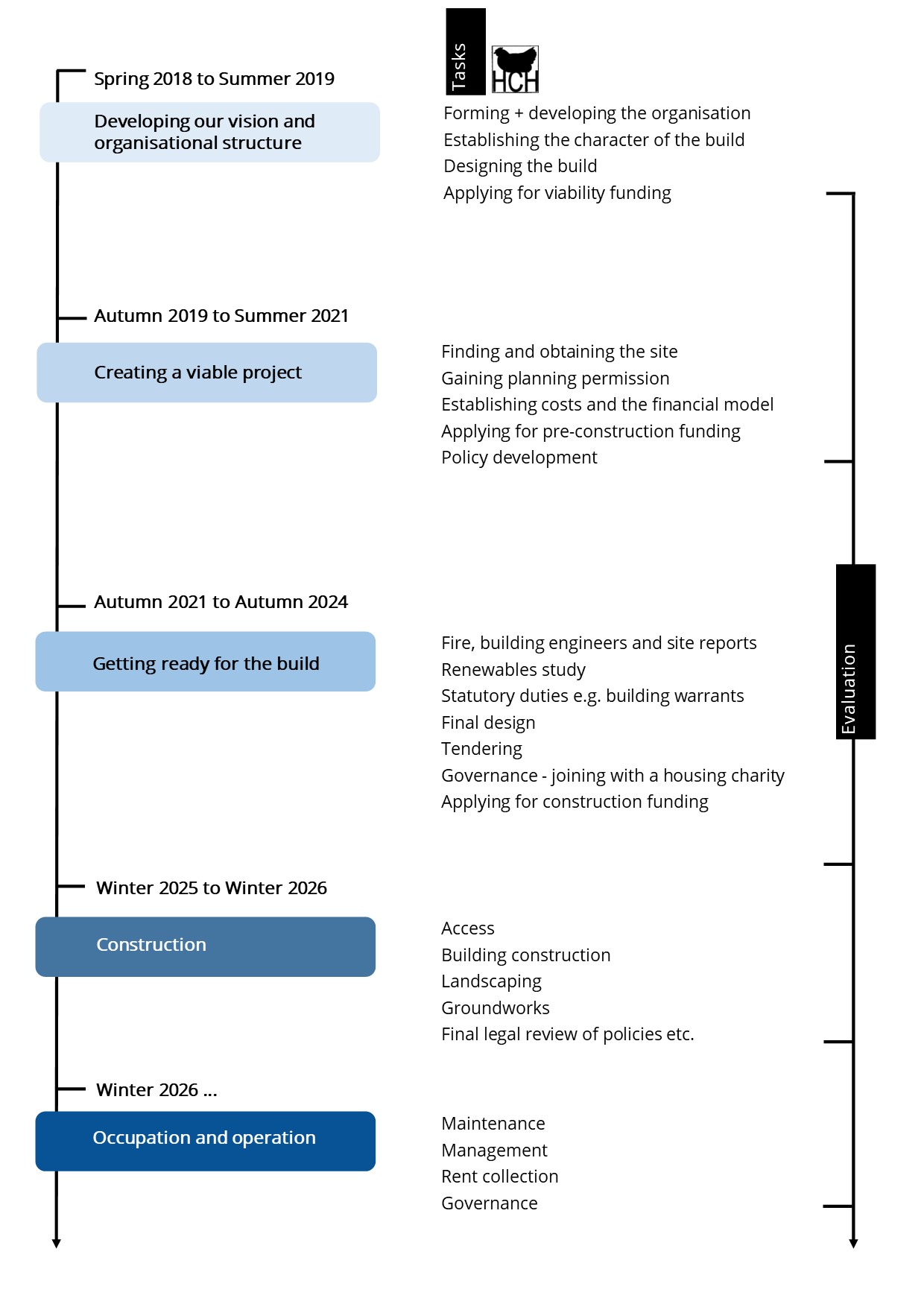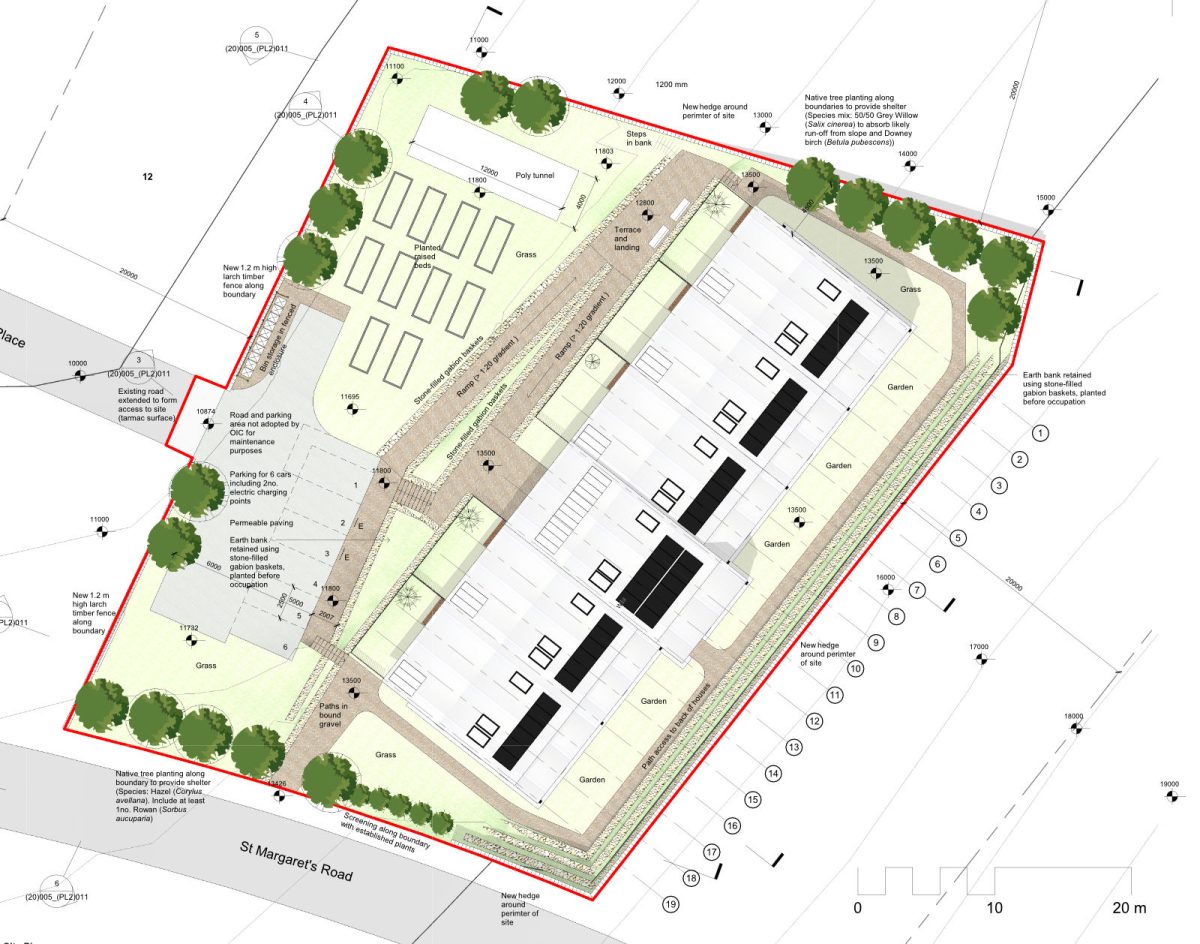There are five phases in a community-led housing project like Hope Cohousing:
Phase 1: developing a vision and the organisational structure
Phase 2: creating a viable project
Phase 3: getting ready for the build
Phase 4: construction
Phase 5: occupation and operation
As a rule of thumb, before people move in, each phase is both more expensive than the previous one, and entails more detailed technical knowledge. We are currently in the midst of Phase 3.
Phase 1: developing a vision and the organisational structure
In the early days of meeting as a group, back in Spring 2018, we decided that converting an existing building would be both difficult and expensive so we committed to a new build. We looked at different tenure options – ownership, shared ownership, rental, or a mixture – and after considering them all we decided to opt for rented houses. Not only does this put residents on an equal footing and make the houses available to all, but it also makes it easier to hand over to future residents.
We spoke to the local housing association about our project and were advised to contact the Orkney Islands Council (OIC) housing department. Fortuitously OIC was already developing ideas with Robert Gordon University (RGU) in Aberdeen for housing projects in Orkney that would include provision for older people. As a user-group looking to take forward our ideas for cohousing, we were given encouragement and great support by both OIC and RGU. Later we realised the appeal of our commitment: a ready-formed group, full of enthusiasm and a belief in our project, looking to make our vision happen.
Creating an organisation
From the outset, we knew we needed to be a corporate body. With the help of Voluntary Action Orkney, we set up a company limited by guarantee. Later we converted it to a Community Interest Company to better reflect our vision of creating lasting benefits for the community.
We are continuing to discuss the most suitable governance structure for Hope Cohousing. This might seem to be a lot of chopping and changing, but relatively few people have set up cohousing projects in Scotland and there is no experience in how to go about developing a fully rental scheme. As a pioneering group, we had no blueprint to follow.
Phase 2: creating a viable project
Looking for land and developing plans
We identified sites that were designated for housing in the local village plan. A green-field site that belonged to OIC but was not going to be developed by them lent itself to our brief
We secured feasibility funding from the Scottish Government’s Rural Housing Fund and that helped Professor Gokay Deveci at RGU School of Architecture to develop plans. It also funded community consultations around Orkney (see the Orkney News). We started the consultation by raising our profile with local media: Radio Orkney, The Orcadian and Orkney News. Public sessions were very well-attended. We were delighted and encouraged by the positive reception from our community.
Engaging a project co-ordinator
Knowing we had the backing of our local authority and community, we next engaged Sacha Woolham as project coordinator. Her skills and energy have rapidly moved us forward. Together with OIC and RGU we developed a bid for Innovate UK’s Healthy Ageing Trailblazer initiative and secured a second-stage interview. This work helped to develop and consolidate our plans.
Working and waiting

In terms of the project’s progress, the predominant theme of lockdown was waiting. We held our weekly meetings online. Our professional team carried on with the planning and tendering processes, but the COVID-19 pandemic inevitably had a major effect on progress, for example around gaining planning permission.
In February 2020 and again in 2021 we were invited to attend Rural Housing Scotland’s annual conference. It was a privilege to talk about Hope Cohousing to a wider audience, but it was even more stimulating to meet other groups developing community projects and to learn from their experience. Click to download our 2020 presentation and watch the video produced for 2021.
Securing the site
In September 2020 a request for financial assistance that we had previously submitted to OIC was considered by the Policy and Resources Committee. They agreed to provide funds from their Crown Estate allocations and at the same time to reduce the price of the site to match. The transfer of land to Hope Cohousing will become effective when the rest of our funding package is in place. The full council endorsed this decision in October 2020. We are reminded again how very fortunate we are to have a local authority which supports us so constructively and recognises the benefits of cohousing, especially for older people.
Getting planning permission
In March 2020 we submitted a planning application. Issues with drainage on the site had to be resolved. COVID-19 and the months of lockdown made the process a far lengthier one than we could ever have anticipated. We were finally granted planning permission on November 16, 2020. However, with rising build costs (see below) we had to change some elements of the design and submitted updated plans based on the same footprint late in 2021. These were approved in February 2022.

Phase 3: getting ready for the build
Funding the preconstruction phase
The total cost of the pre-construction phase is well over £100,000 and it is not surprising that community-led housing projects often fail at this point. Professional fees and statutory costs have to be covered before grants and mortgages can be obtained. This is particularly the case when creating affordable housing for rent as there is no owner-occupier capital available. In Scotland, there is not yet a clear framework for dealing with community-led housing pre-construction costs. A lot of project coordinator Sacha Woolham’s work has been on financial modelling.
We continued to make applications to fund project development and have benefitted from three important awards:
UnLtd recognised the social entrepreneurialism involved in the project early in 2021. They provided much-needed professional support and awarded money that was used to pay for specialist advice and fees.
The Scottish Government’s Rural Communities Ideas Into Action Fund – late in 2021 – and much to our delight, provided over £48,000 to support some of the costs of the preconstruction phase of the project.
Crown Estate Scotland – in March 2022 – made the completion of the preconstruction phase possible. Their Community Capacity Grants Programme awarded the project just under £50,000. This enables us to undertake the work needed to gain the all-important building warrant, get the professional help required, and apply for the funding to construct the houses and make ready the site.
To help us to take the project forward we have enlisted the Communities Housing Trust.
Financing the build
We are now also making funding applications to finance the construction of the shared area of the building which includes laundry facilities and a meeting area. These are not covered by housing grants from the Scottish government – and do not fall into the usual funding categories in relation to health and care services.
Our plan is to make a main fund application to the Scottish Government, raise a mortgage, and look for some additional funding for the housing component. This is basically what housing associations do to fund their schemes. We are currently in discussion with the Islands Housing Fund, mortgage providers, and other potential sources of finance.
Building tenders
Our steep learning curve included dealing with building tenders. We went out to a first-stage tender in 2021 and received two responses from local builders that were both well above budget. Our architect and surveyor revisited both design and construction methods to bring us back on budget. Unfortunately, COVID, Brexit and changes in UK financial policies are increasing building costs.
We went out to our final tendering early in March 2023 and have identified the local builder that we would like to work with.
Updating the design

It isn’t only the cost of the build that has taken us back to the design of the development. Our initial vision involved an internal street that ran the length of the building. It became an externally covered walkway. In the process, we forgot to factor in the weather in Orkney! We have now added in porches and some other changes to improve the experience of living in the housing.
Rethinking governance
As we have progressed the project it has become clear that we need to alter our governance structure to be better positioned in making applications for capital funding – and to function effectively when construction is finished. The changes will probably involve:
• creating an overarching Orkney-based charity so that we can apply to a greater number of funders, draw upon the expertise of a wider range of trustees, and support other local community-led housing initiatives.
• turning our current Community Interest Company into a tenant management organisation that deals with the day-to-day running of the St Margaret’s Hope project.
We are currently working with legal and other specialists to create the appropriate structures etc.
The timeline for the project
Projects like ours have five main phases as can be seen below. We have been able to develop a vision and organisational structure and create a viable project. At the moment we are in the third phase – getting ready for the build (pre-construction). As you can imagine, we have had to alter this diagram several times to reflect changes in the timing of the development.


